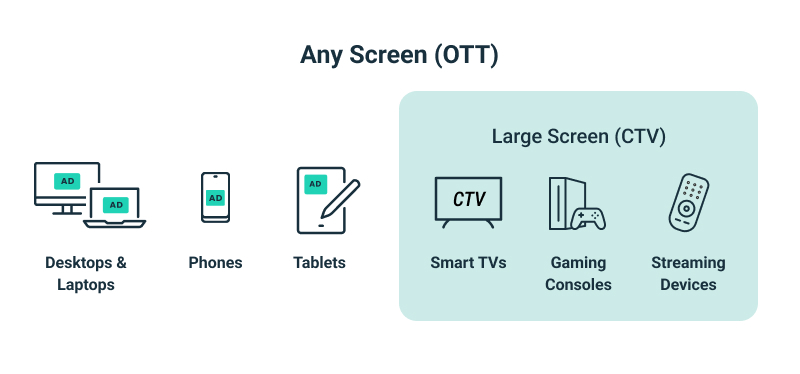Investment in Connected TV (CTV) ads continues to grow across industries. With cord-cutters reaching an all-time high and a variety of new streaming services popping up every year, CTV is quickly becoming one of the best places to reach audiences of all kinds.
Despite the growing popularity, companies still have questions about the power of CTV, how ads on CTV compare to Over-the-Top (OTT) ads, and what real business results they can expect. So, today, we’re giving you everything you need to know about CTV and OTT.
What Are the Differences Between CTV and OTT?
CTV and OTT are often used interchangeably, although there are a few key differences. OTT describes advertising that connects companies to their audiences over the internet. OTT ads are delivered via streaming on devices such as desktops, laptops, phones and tablets, bypassing linear TV providers.
CTV is a device-type that serves OTT ads to customers. The devices include: Smart TVs, those with built-in internet connection and media platform, a streaming device, like Roku, that plugs into a TV to enable apps and streaming, and game consoles that stream, such as Xbox.
In short, all CTV ads are OTT ads, but not all OTT ads are CTV ads.

Why Should CTV and OTT Be In Your Media Mix?
Stakeholders outside the marketing team often ask why they should make room in the budget for CTV and OTT. They sometimes assume that if they invest in mobile advertising and linear TV ads, CTV and OTT would be redundant additions to their media mix. This couldn’t be further from the truth.
Audiences behavior is much different on OTT and CTV devices, and therefore, companies see different results based on the ads they show. Some of the most important differences include:
- Comprehensive Marketing Funnel: Omnichannel marketing strategies are critical to successful ad campaigns. Audiences find their favorite brands through a variety of channels, and often have different levels of trust across those channels. In order to get the most return from marketing spend, companies need to include CTV and OTT ads.
- Audience Behavior: CTV devices, specifically, are designed to keep audiences’ attention. Our phones, tablets, and laptops all can (and are) used for multiple activities at once. CTV only allows for streaming, which increases audience engagement. What’s more, CTV ads aren’t skippable. Audiences are guaranteed to see your full ad when you invest in CTV.
- Reliable Reporting: Unlike linear TV or Out-of-Home advertising, CTV and OTT ads offer the level of performance reporting that companies expect from mobile and other digital ads. At a time when companies are demanding real business results from their marketing team, accurate reporting is essential.
Of course, the reasons a company decides to invest in CTV and OTT will be unique. But, the impact that these ads can make is universal.
How to Drive Foot Traffic and Other Business Results from CTV and OTT
As we mentioned, customers expect omnichannel marketing from their favorite brands. But companies also see better results when they combine a variety of channels to target their different audience segments.
For example, GroundTruth customers have seen a 2x increase in ROAS when they combine CTV ads with mobile ads. They also see a 61% increase in foot traffic using the same combination. Retargetting ads also perform better when they are served as a compliment to CTV and OTT ads. The key is to think of CTV as a critical part of the holistic customer journey. As long as you’re clear on your goals and the audience you want to reach, CTV can help you achieve them.
Learn More About CTV+ with GroundTruth
If you’re ready to invest in CTV and OTT advertising, contact us today! We’ll give you an exclusive look at our newest offering, CTV+, which combines the power of CTV and mobile ads for our customers.





